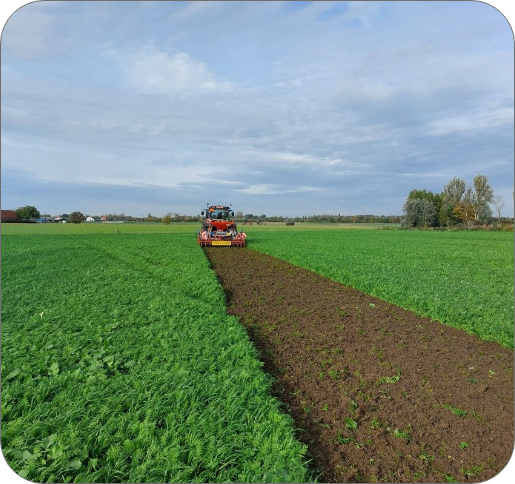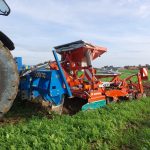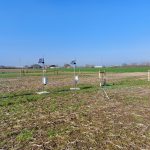
Contact person:
Willem Van Colen, PhD
researcher agroforestry at Inargo

Discover Inagro’s Agroforestry progress on their dedicated subpage here and stay updated with their ‘Digging Deeper’ series:
Digging Deeper 1
Digging Deeper 2
Digging Deeper 3
Digging Deeper 4
Digging Deeper 5
Digging Deeper 6
Digging Deeper 7
Digging Deeper 8
Digging Deeper 9
Digging Deeper 10
Digging Deeper 11
Digging Deeper 12
Digging Deeper 13
Digging Deeper 14
Living Lab 2: Belgium
Managed by: Inagro in cooperation with local farmers doing intercropping
General information
The Living Lab in Belgium is a research field, owned by Inagro. Local commercial farmers are doing intercropping and are commercial farmers. The living lab is planned as a long-term agroforestry research and demonstration site.
On this plot of 1.4 ha, characterised by fertile sandy loam soil, arable crops, and vegetables are grown in between rows of walnut trees. Our strategic aim is to tilt agroforestry as an innovative practice beyond the pioneering phase in Flanders. On the one hand by studying the potential and feasibility of agroforestry to provide science-based figures and information resulting from this practice-oriented good example. On the other, through on-field demonstration or online communication to all stakeholders, including farmers (our main target group), researchers, advisors, policymakers and others.
Via our own agroforestry plot, we are gaining valuable insights and first-hand practical experience on this sustainable food production system that is part of the answer to today’s and future challenges faced by agriculture such as climate change, soil health, water management, and biodiversity.
There is an on-field cooperation between Inagro and local farmers, where Inagro is responsible for managing the trees and tree rows, while a local farmer is doing the intercropping.
Currently, walnut trees were planted in spaced rows allowing for conventional farming of arable crops (potatoes, wheat, maize, field beans) and vegetables (carrot, cabbage, celeriac, leek) in between the rows by a neighboring farmer. Underneath the tree rows, we installed perennial flower strips to attract beneficial insects (natural pest control and pollination).
General farming approach
Inagro deliberately chose to make the living lab a conventional farming system, as only about 3% of farming in Flanders is organic. We don’t want to limit the practice of agroforestry to this 3%, but we want to show that also in conventional farming agroforestry can be feasible, profitable and beneficial for soil, water, and biodiversity.
Objectives
The main objective is a demonstration of the production of vegetables, arable crops, and walnuts in a way that farmers can still make a profitable income, but at the same time improve soil conditions, increase biodiversity, and the resilience of their field and farm.
Challenges
- Introduction of trees in highly intensive farming landscape, dominated by lucrative vegetable farming
- Local farmer sentiment: Generally negative towards trees, citing perceived competition with crops for resources
- Limited experience among local farmers in tree management and harvest techniques
Research goals
- Assessing the long-term impact of the trees and agroforestry practice on soil, water, microclimate, and biodiversity.
- Determine the economic profitability of this specific agroforestry system in the long term. With a focus on how species/variety choice or management of crops and trees can be optimized to increase crop yield.
Design of the agroforestry system
The choice for walnut trees is based on the strongly increasing interest of farmers in these trees, their high economic potential, and their suitability for application in agroforestry systems. The 3-meter-wide strips underneath the walnut trees will be sown in with a perennial mix of grasses and herbs, with the aim of limiting the management of these strips and attracting beneficial insects. The trees will be intercropped with arable crops and vegetables typical for our region, in a 6-year rotation (potatoes, celeriac/carrot, maize, leek/ cabbage, winter wheat, and field beans). Perpendicular to the dominant wind direction (SW), a hedge will be planted as a windbreak and habitat for insects and birds. The plot will be managed in a conventional way.
Monitoring
Second, we focus on the provision of ecosystem services by monitoring the impact on soil quality, carbon storage, water management, and biodiversity. Concerning the soil we will measure chemical parameters such as nutrients, organic matter, and pH, and physical parameters such as bulk density, texture, and water infiltration capacity. Soil macro- and micro biodiversity will be monitored as well. For macro- organisms focus will be on earthworms and ground beetles. All measures will be performed yearly where relevant and possible. Transects of tensiometers will be monitoring the soil moisture between tree rows during the crop growth season.

Belgium

1.4 ha

Silvoarable, silvohorticulture, hedgerows, shelterbelts, and riparian buffer strips

Silvoarable & horticulture

Established in 2023

Inter-row/In-row distance: 24m/ +-8m

Width of tree strips: 3 m

Number of trees: 50

6-year rotation of potato, mais, winter wheat, leek/ cabbage, carrot/celeriac, field beans

Livestock: No







